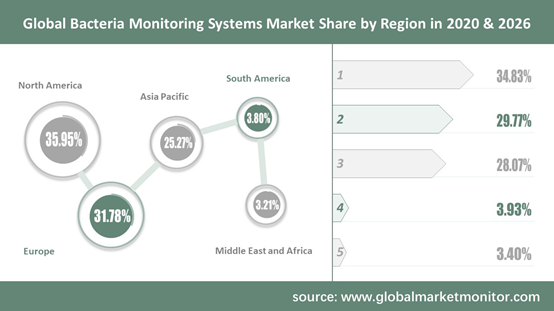A bacteria monitoring system is a device used to monitor bacteria, which can monitor bacteria in gas, water and dust. Gas monitoring systems can identify problematic microorganisms in gas for planning and management. Bacteria are microscopic, single-celled organisms that can be found in almost any environment. Water quality monitoring systems can be used to monitor bacteria in the water environment. Dust also contains very small communities of microbes, such as bacteria, fungi and viruses, which are made up of very small organisms. Dust monitoring systems can be used to monitor bacteria in dusty environments. In 2020, the market shares of these three bacterial detection systems are 19.24%, 57.66%, and 13.81%, respectively. In 2026, the share of various monitoring systems will be 20.77%, 55.67%, and 14.09%, respectively.
Effective bacterial monitoring helps reduce final contamination levels, thereby improving quality and reducing risk. At present, bacterial monitoring systems are commonly used in the monitoring and control of bacteria in pharmaceutical factories in the pharmaceutical industry, and also in food safety monitoring and control in the food industry. In addition, the bacterial monitoring system can also be used in clinical, energy, environmental, chemical, materials and other industries that require rapid detection of bacterial contamination. In 2020, bacterial monitoring systems used in pharmaceutical, clinical, food, energy, chemical materials, environment and other fields will account for 11.58%, 5.43%, 24.09%, 10.82%, 7.90%, and 40.17% of the market share. It can be seen that the environment and food processing have the greatest demand for bacterial monitoring systems. In 2020, the market shares of bacterial monitoring systems in various fields are 12.53%, 5.82%, 23.57%, 9.83%, 7.43%, and 40.82%, respectively.
Bacterial monitoring systems provide a fast and reliable solution for real-time monitoring of eventual bacterial contamination, protecting a company\'s brand, reputation and customers. Many companies are now adopting bacterial monitoring systems.
Global Bacterial Monitoring Systems Market Revenue Lowered in 2020 Amid Economic Slowdown and COVID-19 Impact
North America is the largest revenue market in the bacterial monitoring system industry, with a market share of 36.86% in 2015 and 35.95% in 2020, a decrease of 0.91%. In 2020, the market shares of Europe, Asia Pacific, South America, Middle East and Africa are 31.78%, 25.27%, 3.80% and 3.21% respectively. By 2026, the North America, Europe, Asia Pacific, South America, Middle East and Africa market share will be 34.83%, 29.77%, 28.07%, 3.93%, 3.40%. It can be seen that in Asia Pacific, South America, the Middle East and Africa, due to the continuous economic development of emerging developing countries, serious environmental pollution, and improved understanding of bacterial detection, the demand has increased.

Get the Complete Sample, Please Click:https://www.globalmarketmonitor.com/reports/879440-bacteria-monitoring-systems-market-report.html
In recent years, the macroeconomic development in Europe and North America has been slow, and the growth rate of the manufacturing industry has slowed down, which has adversely affected the development of the bacteria monitoring system industry. At the same time, China, as a country with a large manufacturing production and demand, has slowed down its economic growth. China\'s GDP growth in 2019 was 6.1%, the slowest year since 1990. The slowdown in macroeconomic growth has also affected the production and demand for bacterial monitoring systems.
suffered the shock of COVID-19. In 2020, the global COVID-19 outbreak wreaked havoc on the global economy, and bacteria surveillance systems took a hit.
The Bacteria Monitoring Systems industry has a moderate concentration. The top three companies are Thermo Fisher Scientific, Bio-Rad Laboratories, and Idexx Laboratories, with 2019 revenue market shares of 11.37%, 9.65%, and 7.48%, respectively.
With the Development of the Economy and the Progress of Society, the Downstream Demand for Bacterial Monitoring Systems is Increasing
The incidence of foodborne illness or food-related poisoning is increasing due to food spoilage. The frequent occurrence of food contamination incidents has led to an increasing demand for food safety testing by global food manufacturers. Preventing the contamination of the food supply by microorganisms is one of the fundamental principles of food safety and product quality. The monitoring and evaluation of bacteria in food can verify food safety and eliminate the risk of bacterial contamination in the food industry. Therefore, manufacturers conduct bacterial monitoring in the food industry to detect various bacterial contaminations, which will be an important driver for bacterial monitoring systems.
Freshwater resources are declining at an alarming rate. Growing water scarcity is one of the main challenges facing sustainable development today. This challenge will become more urgent as the world\'s population continues to increase, living standards improve, and the impacts of dietary change and climate change intensify. The increasing demand for water and the deterioration of natural water quality have been a constant concern, especially in the water treatment industry. Whether in the drinking water industry or the industrial water industry, permanent water monitoring has become a necessity.
Research data shows that the total revenue of the global bacteria monitoring systems market was USD 1539.53 million in 2015 and increased to USD 1923.42 million in 2019. Growing global economy, increasing population, and growing market demand are playing an active role in expanding the bacteria monitoring systems market. We predict that the bacteria monitoring systems market can be valued at USD 2443.18 million by 2026. Bacteria monitoring systems will register a CAGR of 5.32% from 2020 to 2026.
Get the Complete Sample, Please Click:https://www.globalmarketmonitor.com/reports/879440-bacteria-monitoring-systems-market-report.html
We provide more professional and intelligent market reports to complement your business decisions.